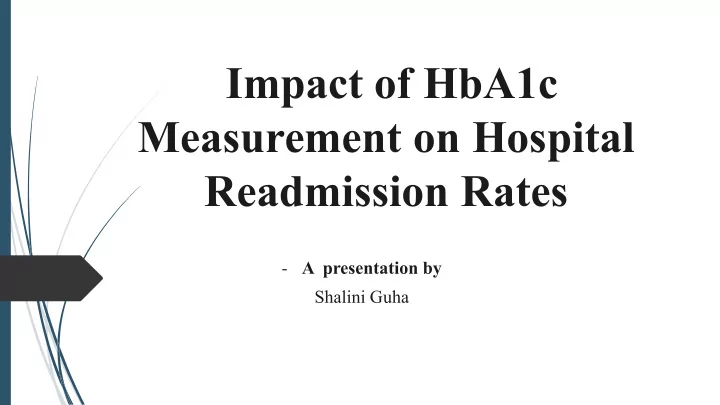

Impact of HbA1c Measurement on Hospital Readmission Rates - A presentation by Shalini Guha
Diabetes mellitus is a chronic disorder associated with disturbances in carbohydrate, fat, and protein metabolism and characterized by hyperglycemia. It is one of the most prevalent diseases in the world. The motivation of this study is to use data science to help focus treatment development on more effective forms of treatment. HbA1c refers to glycated hemoglobin and it develops when glucose joins with hemoglobin, that is responsible for carrying oxygen throughout the body. The hemoglobin is then said to be ‘glycated’ and by measuring this ‘glycated hemoglobin’ level, an estimate about the average blood sugar level over a period of weeks/months can be made
The dataset represents 10 years (1999-2008) of clinical care at 130 US hospitals and integrated delivery networks (An Integrated Delivery Network (IDN) is a formal system of providers and sites of care that provides both health care services and a health insurance plan to patients in a particular geographic area.). It includes over 50 features representing patient and hospital outcomes. Information was extracted from the database for encounters that satisfied the following criteria. It is an inpatient encounter (a hospital admission). It is a diabetic encounter, that is, one during which any kind of diabetes was entered to the system as a diagnosis. The length of stay was at least 1 day and at most 14 days. Laboratory tests were performed during the encounter. Medications were administered during the encounter.
Relative Importance of Variables
It was observed that people who were primarily diagnosed to be suffering from circulatory diseases had a higher readmission rate based on values of the HbA1c test whereas readmission of those with diabetes as primary diagnosis were independent of the HbA1c test value but were highly affected by its presence. Hence, the HbA1c test can help in significantly improving readmission policies in hospitals by accurate predictions of readmission rates. When hyperglycemia management is championed from admission through discharge, patients are more likely to experience improved outcomes and increased patient satisfaction, and hospitals are more likely to achieve substantial cost savings.
Recommend
More recommend